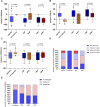Conduction system pacing upgrade versus biventricular pacing on pacemaker-induced cardiomyopathy: a retrospective observational study
- PMID: 39108542
- PMCID: PMC11300236
- DOI: 10.3389/fphys.2024.1355696
Conduction system pacing upgrade versus biventricular pacing on pacemaker-induced cardiomyopathy: a retrospective observational study
Abstract
Objective: The feasibility of the conduction system pacing (CSP) upgrade as an alternative modality to the traditional biventricular pacing (BiVP) upgrade in patients with pacemaker-induced cardiomyopathy (PICM) remains uncertain. This study sought to compare two modalities of CSP (His bundle pacing (HBP) and left bundle branch pacing (LBBP)) with BiVP and no upgrades in patients with pacing-induced cardiomyopathy. Methods: This retrospective analysis comprised consecutive patients who underwent either BiVP or CSP upgrade for PICM at the cardiac department from 2017 to 2021. Patients with a follow-up period exceeding 12 months were considered for the final analysis. Results: The final group of patients who underwent upgrades included 48 individuals: 11 with BiVP upgrades, 24 with HBP upgrades, and 13 with LBBP upgrades. Compared to the baseline data, there were significant improvements in cardiac performance at the last follow-up. After the upgrade, the QRS duration (127.81 ± 31.89 vs 177.08 ± 34.35 ms, p < 0.001), NYHA class (2.28 ± 0.70 vs 3.04 ± 0.54, p < 0.05), left ventricular end-diastolic diameter (LVEDD) (54.08 ± 4.80 vs 57.50 ± 4.85 mm, p < 0.05), and left ventricular ejection fraction (LVEF) (44.46% ± 6.39% vs 33.15% ± 5.25%, p < 0.001) were improved. There was a noticeable improvement in LVEF in the CSP group (32.15% ± 3.22% vs 44.95% ± 3.99% (p < 0.001)) and the BiVP group (33.90% ± 3.09% vs 40.83% ± 2.99% (p < 0.001)). The changes in QRS duration were more evident in CSP than in BiVP (56.65 ± 11.71 vs 34.67 ± 13.32, p < 0.001). Similarly, the changes in LVEF (12.8 ± 3.66 vs 6.93 ± 3.04, p < 0.001) and LVEDD (5.80 ± 1.71 vs 3.16 ± 1.35, p < 0.001) were greater in CSP than in BiVP. The changes in LVEDD (p = 0.549) and LVEF (p = 0.570) were similar in the LBBP and HBP groups. The threshold in LBBP was also lower than that in HBP (1.01 ± 0.43 vs 1.33 ± 0.32 V, p = 0.019). Conclusion: The improvement of clinical outcomes in CSP was more significant than in BiVP. CSP may be an alternative therapy to CRT for patients with PICM. LBBP would be a better choice than HBP due to its lower thresholds.
Keywords: biventricular pacing; cardiac resynchronization therapy; conduction system pacing; heart failure; pacemaker-induced cardiomyopathy.
Copyright © 2024 Pei-pei, Ying, Yi-heng, Guo-cao, Cheng-ming, Qing, Lian-jun, Yun-long and Ying-xue.
Conflict of interest statement
The authors declare that the research was conducted in the absence of any commercial or financial relationships that could be construed as a potential conflict of interest.
Figures




References
-
- Abdin A., Aktaa S., Vukadinovic D., Arbelo E., Burri H., Glikson M., et al. (2022). Outcomes of conduction system pacing compared to right ventricular pacing as a primary strategy for treating bradyarrhythmia: systematic review and meta-analysis. Clin. Res. Cardiol. 111, 1198–1209. 10.1007/s00392-021-01927-7 - DOI - PMC - PubMed
-
- Chen S., Yin Y., Lan X., Liu Z., Ling Z., et al. (2013). Paced QRS duration as a predictor for clinical heart failure events during right ventricular apical pacing in patients with idiopathic complete atrioventricular block: results from an observational cohort study (PREDICT-HF). Eur. J. Heart Fail 15, 352–359. 10.1093/eurjhf/hfs199 - DOI - PubMed
-
- Cheung J. W., Ip J. E., Markowitz S. M., Liu C. F., Thomas G., Feldman D. N., et al. (2017). Trends and outcomes of cardiac resynchronization therapy upgrade procedures: a comparative analysis using a United States National Database 2003-2013. Heart rhythm. 14, 1043–1050. 10.1016/j.hrthm.2017.02.0172017.02.017 - DOI - PubMed
LinkOut - more resources
Full Text Sources
Research Materials
Miscellaneous

